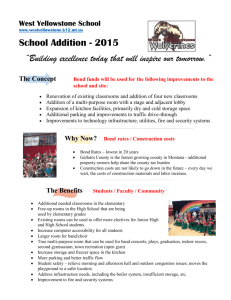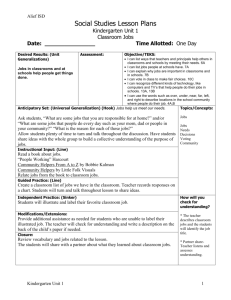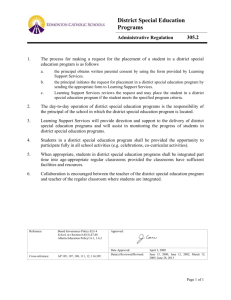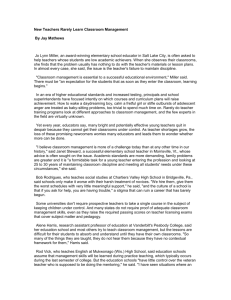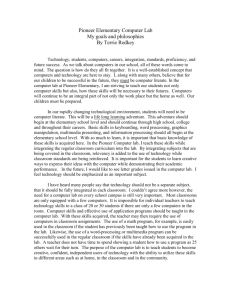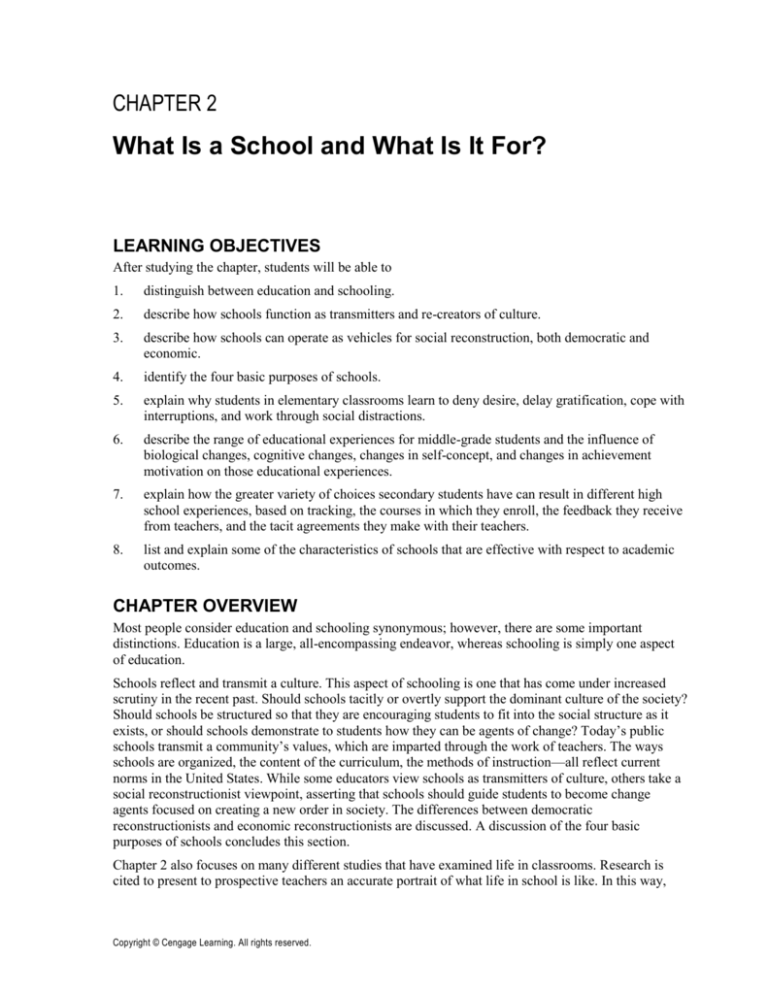
CHAPTER 2
What Is a School and What Is It For?
LEARNING OBJECTIVES
After studying the chapter, students will be able to
1.
distinguish between education and schooling.
2.
describe how schools function as transmitters and re-creators of culture.
3.
describe how schools can operate as vehicles for social reconstruction, both democratic and
economic.
4.
identify the four basic purposes of schools.
5.
explain why students in elementary classrooms learn to deny desire, delay gratification, cope with
interruptions, and work through social distractions.
6.
describe the range of educational experiences for middle-grade students and the influence of
biological changes, cognitive changes, changes in self-concept, and changes in achievement
motivation on those educational experiences.
7.
explain how the greater variety of choices secondary students have can result in different high
school experiences, based on tracking, the courses in which they enroll, the feedback they receive
from teachers, and the tacit agreements they make with their teachers.
8.
list and explain some of the characteristics of schools that are effective with respect to academic
outcomes.
CHAPTER OVERVIEW
Most people consider education and schooling synonymous; however, there are some important
distinctions. Education is a large, all-encompassing endeavor, whereas schooling is simply one aspect
of education.
Schools reflect and transmit a culture. This aspect of schooling is one that has come under increased
scrutiny in the recent past. Should schools tacitly or overtly support the dominant culture of the society?
Should schools be structured so that they are encouraging students to fit into the social structure as it
exists, or should schools demonstrate to students how they can be agents of change? Today’s public
schools transmit a community’s values, which are imparted through the work of teachers. The ways
schools are organized, the content of the curriculum, the methods of instruction—all reflect current
norms in the United States. While some educators view schools as transmitters of culture, others take a
social reconstructionist viewpoint, asserting that schools should guide students to become change
agents focused on creating a new order in society. The differences between democratic
reconstructionists and economic reconstructionists are discussed. A discussion of the four basic
purposes of schools concludes this section.
Chapter 2 also focuses on many different studies that have examined life in classrooms. Research is
cited to present to prospective teachers an accurate portrait of what life in school is like. In this way,
Copyright © Cengage Learning. All rights reserved.
24
Chapter 2: What Is a School and What Is It For?
prospective teachers can broaden their perception of school life beyond their own experiences and can
think about their role in the classroom.
The studies reported look at school life at different levels: elementary, middle, and high school. Philip
Jackson’s study of life in elementary classrooms explains how daily routines shape the experiences of
both teachers and students. Student experiences in the middle grades, between sixth and eighth grades,
are strongly influenced by biological changes, cognitive changes, changes in self-concept, and changes
in achievement motivation occurring in students of this age. Various types of high schools are defined
and the variety of options available to secondary students in each type of school are explained.
Many studies have been conducted regarding the characteristics of effective schools. After choosing a
common definition of “effectiveness,” the characteristics that have been identified in these studies in
schools are described.
Student readers should recognize the range and diversity of schools. For that reason, we encourage
them to compare their own experiences of schooling with the ideas described in this chapter. We expect
that class discussion will highlight differences and similarities in their schooling. For prospective
teachers to be effective, reflective instructors as well as participants in renewing schools, it is
imperative that they understand the competing conceptions of schools as well as the effects of efforts to
change and improve schools.
CHAPTER OUTLINE
I.
Education and Schooling
A. Education
B. Schooling
II. Schools as Cultures
A. Socialization
III. Schools as Transmitters or Re-creators of Culture
A. Transmitting Culture
1. Acculturation and Diversity
B. Reconstructing Society
1. Democratic Reconstructionists
2. Economic Reconstructionists
IV. Four Basic Purposes of School
A. Intellectual Purposes
B. Political and Civic Purposes
C. Economic Purposes
D. Social Purposes
V. What Do Studies Reveal About the Nature of Schools?
A. Life in Elementary Schools
1. The Teacher’s Role
2. What Students Experience
B. Life in Middle and Junior High Schools
1. Types of Schools
2. Developmental or Academic Purposes Foremost?
C. Life in High Schools
1. Multiple Purposes
2. The Shopping Mall High School
VI. What Is a Good School?
A. Characteristics of an Effective School
1. The Teacher’s Expectations
Copyright © Cengage Learning. All rights reserved.
Chapter 2: What Is a School and What Is It For?
25
2. Communication Among Teachers
3. Task Orientation
4. Academic Engaged Time
5. Behavior Management
6. The Principal
7. Parents
8. The School Environment
VII. The Unfinished Work of the Schools
SUPPLEMENTARY LECTURE AND DISCUSSION TOPICS
1.
Teacher: The creator or transmitter of culture? In greater detail, present to your class how the
teacher can be either the creator or transmitter of culture. Explore the realities of a teacher being
either a transmitter or a creator of culture. What obstacles does one face as a teacher fully
committed to the cause of reconstruction? To what extent can a teacher be a convincing
transmitter of culture? Are the elements of a teaching job and the requirements for social
reconstruction too disparate to expect teachers, in general, to work actively to change society? Is
there a basic mismatch between those who would continue to teach because of the stability of the
profession, and the active participation and risk taking required of those committed to social
reconstruction?
2.
Privatization Discuss how privatization groups like the Edison Project affect the schools they
take over. Can decisions be too influenced by the economics of the design? What risks does
privatization hold?
3.
Future instruction in high school Boyer and Cuban studied high school programs and came up
with very different recommendations for change. Boyer advocated revitalizing programs by
sweeping changes in teaching. Cuban advocated strengthening teacher-centered instruction.
Review the work of these authors, and discuss the implications for students and high schools if
either approach were to be adopted.
4.
Tracking in the high school Although much has been written criticizing the use of tracking in
high school, many, if not most, public high schools still do some tracking. Examine the arguments
for and against tracking. Explore some of the common questions surrounding tracking. How does
tracking affect a student’s self-image? How can a teacher provide enough challenges for a bright
student in a mixed-ability class so that he or she won’t be held back? How can a teacher
effectively teach a classroom of heterogeneous students? What are the differences in class size in
the different tracks? How do teachers view teaching “honors” or “general”-level classes? Finally,
you may want to share with your students a high school curriculum that uses tracking. Look at the
curriculum, for example, of the ninth-grade general science class and the ninth-grade college
preparatory science class. What are the differences in activities? Textbooks? Skills to be covered?
Copyright © Cengage Learning. All rights reserved.
26
Chapter 2: What Is a School and What Is It For?
STUDY GUIDE—CHAPTER 2: WHAT IS A SCHOOL AND WHAT IS IT
FOR?
Completing this study guide will help you prepare for the major topic areas on an exam; however, it
does not cover every piece of information found in the chapter or the test questions.
1.
2.
Define and contrast these terms:
a.
Education
b.
Schooling
Give an example of schools functioning as
a.
Re-creators of culture
b.
Transmitters of culture
3.
Describe the four basic purposes of school.
4.
List and describe some of the common experiences of elementary students.
5.
Describe the characteristics of 11-13 year-olds that influence the educational experiences found in
middle schools.
6.
Name and describe the common characteristics of high schools.
Copyright © Cengage Learning. All rights reserved.
Chapter 2: What Is a School and What Is It For?
7.
Describe the characteristics of effective schools presented in either the academic outcomes or
holistic point of view in the chapter.
Copyright © Cengage Learning. All rights reserved.
27
28
Chapter 2: What Is a School and What Is It For?
ADDITIONAL RESOURCES FOR INSTRUCTORS
Boyer, Ernest. Basic School: A Community for Learning. Princeton, NJ: The Carnegie Foundation for
the Advancement of Teaching, 1995. This is the last book written by one of education’s greatest
practitioners and spokesmen. It is a statement filled with practical wisdom woven into a clear
description of the kind of schools we can and should have.
Chiarelott, Leigh, Leonard Davidman, and Kevin Ryan. Lenses on Teaching: Developing Perspectives
on Classroom Life. Clifton Park, NY: Wadsworth Publishing, 2006. A combination workbook and
source of information that preservice teachers can use to guide their observations in their fieldwork and
student teaching experience. A variety of topics is covered, and activities allow readers to self-reflect as
well as analyze what they see in classrooms.
Dufour, Richard, Robert Eaker, and Rebecca Dufour. On Common Ground: The Power of Professional
Learning Communities. Bloomington, IN: Solution Tree, 2005. Strategies for encouraging professional
learning communities in schools.
Dufour, Richard, Robert Eaker, and Rebecca Dufour. Revisiting Professional Learning Communities at
Work: New Insights for Improving Schools. Bloomington, IN: Solution Tree, 2008. This text offers
research and insights into leadership and best practices that have proven successful in implementing the
professional learning community concept in schools.
Eaker, Robert, Richard Dufour, and Rebecca Dufour. Getting Started: Reculturing Schools to Become
Professional Learning Communities. Bloomington, IN: Solution Tree, 2002. This text answers
common questions asked by school leaders as they begin the process of transforming their school
cultures into professional learning communities.
Good, Thomas, and Jere Brophy. Looking in Classrooms. 10th ed. New York: Longman, 2007. This
classic text offers a popular, class-tested examination of strategies for observing and describing
classroom teaching. It contains a concise and authoritative review of classroom research combined with
specific teaching recommendations.
Goodlad, John I. A Place Called School, Twentieth Anniversary Edition. New York: McGraw-Hill,
2004. Goodlad and his team of researchers spent several thousand hours collecting data on what schools
are actually like. The book is a detailed, scholarly look at the events, forces, and philosophies that shape
U.S. schools.
Hansen, David, Mary Erina Driscoll, Rene Vincente Arcilla, and Philip Jackson. A Life in Classrooms:
Philip W. Jackson and the Practice of Education. New York: Teachers College Press, 2007. Examines
Jackson’s earlier research on life in classrooms and its continued impact on current educational
practice.
Jackson, Phillip W. Life in Classrooms. New York: Teachers College Press, 1990. This classic provides
insight into the routines, interactions, and the way students experience life in classrooms.
McEwan, Elaine. Ten Traits of Highly Effective Schools: Raising the Achievement Bar for All
Students. Thousand Oaks, CA: Corwin Press. This text identifies the critical attributes of schools that
promote and attain academic excellence for all students.
Sizer, Theodore R. Horace’s Hope: What Works for the American High School. Boston: Houghton
Mifflin, 1996. The third book in Sizer’s Horace trilogy, this book embodies the principles espoused by
the Coalition of Essential Schools, a reform-oriented association of secondary schools.
Copyright © Cengage Learning. All rights reserved.
Chapter 2: What Is a School and What Is It For?
29
Media Resources
The Breakfast Club (MCA, 1985).This movie centers around a Saturday morning detention that a group
of students from different cliques must serve. Throughout the morning, they talk and challenge each
other’s perceptions of who they really are. The movie captures much of the uncertainty teenagers have
about their social position, while revealing their aspirations for the future.
Capturing the Essentials: High Schools That Make Sense (Insight Media, 35 min., 1998). Theodore
Sizer profiles three exemplary high schools showing how their learning environments are shaped by
fundamental ideas that transcend issues of curriculum and standards.
Films for the Humanities website: http://ffh.films.com/Subject.aspx?psid=0&SubjectID=711 offers a
wide variety of videos for purchase on many of the topics found in this chapter.
Insight Media website: http://www.insight-media.com/ offers a wide variety of videos for purchase as
well as a large selection of topics available through digital streaming. Many topics found in this
chapter are addressed through these video selections.
Leading Indicators of Effective Schools (Insight Media, 72 min., 2000). Outlines a system for
evaluating schools based on seven factors including school environment, and relationship of parents
and teachers.
Motivationally Anchored Schools (Insight Media, 25 min., 2003). Illustrates the premise that schools
must support teachers in the effort to keep students motivated in order to be successful.
Partnership for 21st Century Skills website, video link: http://the
partnershipfor21stcenturyskills238.eduvision.tv/default.aspx. Contains videos on a wide range of
topics related to 21st century teaching and learning posted by a range of people including research
professionals, conference presenters, as well as practitioners.
The Quality School (Insight Media, 207 min., 1993). Dr. William Glasser discusses how reality therapy
and control theory can be applied to schools. He provides practical suggestions for creating a quality
school where administrators, teachers, counselors, parents, and students work together to provide all
students with an education based upon cooperation and established standards.
Through New Eyes: Examining the Culture of Your School (Solution Tree, 30 min., 2003). Guides
leaders in assessing school culture as a first step to promoting change.
Twenty-First Century Middle School (Insight Media, 30 min. 1995). With the dramatically changing
nature of students, what must middle schools do to respond? This video looks at various methods that
the Mandarin Middle School in Jacksonville, Florida, used to address these issues.
Media distributor contact information is available in Appendix II.
Student Activities
School Observation—Rating a School’s Effectiveness
Give students the following assignment—individually or in pairs.
It is part of our human nature to make judgments and to gauge people, things, and events according to
our preferences. For the moment we would like you to turn off your critical judging capacity and think
of an elementary, middle, or high school with which you are familiar. If you have recently visited a
school in connection with your education course, use that school; if not, use a school you personally
attended.
Copyright © Cengage Learning. All rights reserved.
30
Chapter 2: What Is a School and What Is It For?
After selecting a school, follow these next steps: First, list the criteria you believe contribute to an
outstanding school. The list can be composed of both positive items (“The teachers are friendly”) and
positive items stated negatively (“Children are not fearful while at school”). Second, review the
sections in this chapter that deal with the research on characteristics of effective schools, and add four
or five items to your list. Third, refresh your memory and past impressions of the school you have
selected for this exercise. Take a mental journey through the school. Bring to the front of your mind
several teachers, staff members, and administrators. Recall what it is like in various classes, the
cafeteria, the playground, and other spots around the school that you observed or frequented. Now
you’re ready to evaluate your school’s effectiveness.
a.
Rate your school on a ten-point scale (with 10 being “truly excellent” and 1 being “very
poor”) on each of the items on your list.
b.
Write the strongest bit of concrete observable evidence for each of your judgments. For
example, for the criterion “Teachers are friendly” you might write, “Teachers smile at and
talk to students in a friendly way in the halls.”
c.
What are the key factors, such as poor leadership or unsupportive parents, that keep this
school from reaching its full potential? List observable evidence for these points also.
Review your findings and answer the following question: If you were given complete control over
this school and wished to make it truly outstanding, what are the three changes you would put into
effect?
Four Purposes of Schooling
Ask the students to consider the same school selected in activity one, and review the observation data
they have collected when thinking about the four basic purposes of schools. Ask them to use their data
to determine whether or not they see one of the four primary purposes standing out more than the others
or if they have observed a mixture of purposes in the school. What school factors make them identify
the purposes they do?
Transmitter of Culture or Social Reconstructionist Debate
Based on the number of students in your class, divide them into groups of four to six. Assign each side
as a supporter of the “transmitter of culture” position or the “social reconstructionist” position. Allow
each group adequate time to research the theory that it supports. At a scheduled date, conduct a debate
between the groups that support the view of schools as transmitting the culture and the groups that
support the view of schools as reconstructionist. If you will have more than one debate, stagger the
debate times so that no one observes another debate before his or her team debates. After students have
conducted their debate, they may sit in on other teams’ debates. If possible, videotape each debate, and
schedule some time outside of class so that the students can watch the debates they missed. As a class,
discuss the issues debated. What are the relative merits of each of the theories? Which points made
were particularly strong? Did the debates change or modify people’s views on one conception of
schools or another?
Case Studies of Student Life
Have each student shadow an elementary, middle school or secondary school pupil for the duration of
the school day. (If necessary, this might be a “day” pieced together from separate short visits.) Be sure
students have the pupil’s and his or her teachers’ permission. Invite comments and analysis regarding
Copyright © Cengage Learning. All rights reserved.
Chapter 2: What Is a School and What Is It For?
31
the observations. Suggest using a stopwatch to document the number of minutes the student spends in
academic on-task time. The class might develop a “reporting sheet” in advance to expedite this activity.
Tracking
Students should interview three or more elementary and/or secondary school teachers to learn their
views on tracking or ability grouping. Does the school they teach in track or ability-group students? In
what subjects? How do the teachers feel about this practice? What effects do they see on their students’
affective or cognitive development?
The Role of Rules
Rules and regulations seem to play an important role in our schools. Have students think back to their
elementary, middle, or high school days. Make a composite list of some school or classroom rules and
regulations that they remember. Have students make a mark next to those rules/regulations that seem
arbitrary or unfair. While students are observing in classrooms, have them note which rules are still in
place in today’s classrooms. Have them consider those rules from the teacher’s perspective or ask the
teacher(s) they are observing their rationale for these rules. In a full class discussion, have students state
why they marked certain rules. Have students discuss whether there are reasons for these rules that they
understand better now, especially after visiting classrooms and talking with the teacher(s).
Copyright © Cengage Learning. All rights reserved.
32
Chapter 2: What Is a School and What Is It For?
Student Assignments
The following activities are suggestions for student portfolio activities. They are a means of providing
alternative assessment of students’ capabilities.
Independent Reading
Read and respond to any of the selections noted on the chapter/article correlation list found on the
Instructor’s Companion Website for Ryan/Cooper, Kaleidoscope: Readings in Education (Cengage
Learning, 2013). You may want to use the Article Review Form in Kaleidoscope.
Reflective Papers
Choose one of the following topics to write a reflective paper (2–5 pages). The purpose of the paper is
to help you assimilate new knowledge by blending it with your previous knowledge and experiences.
1.
Consider your own school experience. As a student, how did the purposes of the school become
evident to you? What were the positive and negative aspects of your own school? Did the school
appear to transmit culture or reconstruct it?
2.
Based upon your observation of your field-site school (or another school where you have had
experience), write what you perceive to be the school’s formal statement of purpose. Consider the
range of purposes the school serves as you prepare this statement.
3.
Schools, historically, have transmitted the dominant culture of society. Describe several instances
of cultural transmission in your own schooling or in the school where you observe. Analyze your
own reflections.
Journal Reflections
Suggestions for journal topics for students’ selection:
1.
Name one common practice in schools that you would like to change, and describe how you
would change it.
2.
Describe how the routines, methods, or organization in an elementary classroom could be altered
to change the students’ experience.
TeachSource Video Cases
The TeachSource video case Parental Involvement in School Culture lets you view one example of how
parents can contribute to an effective school. Access the video case on the Education CourseMate
website through CengageBrain.com. As you watch the clips and study the artifacts in the case, reflect
upon the following questions:
Which of the other aspects of an effective school and of effective teaching can you see in the
portrayals in this video case?
Were parents involved in the schools you have attended? How? How could their
involvement have been improved?
Do you as a teacher feel comfortable about involving parents in your classroom? If not,
what can you do now to address your concerns?
Copyright © Cengage Learning. All rights reserved.


